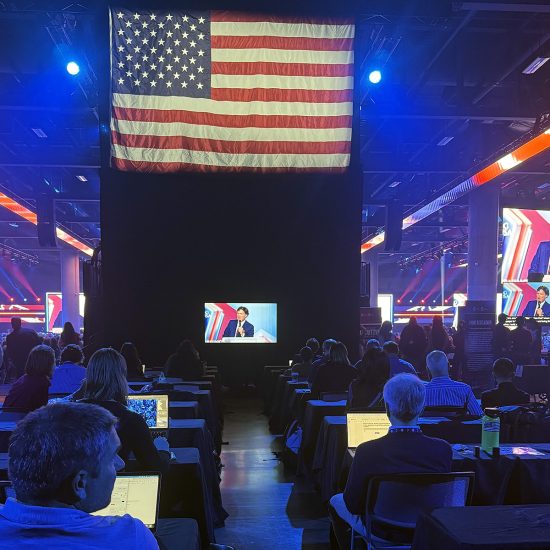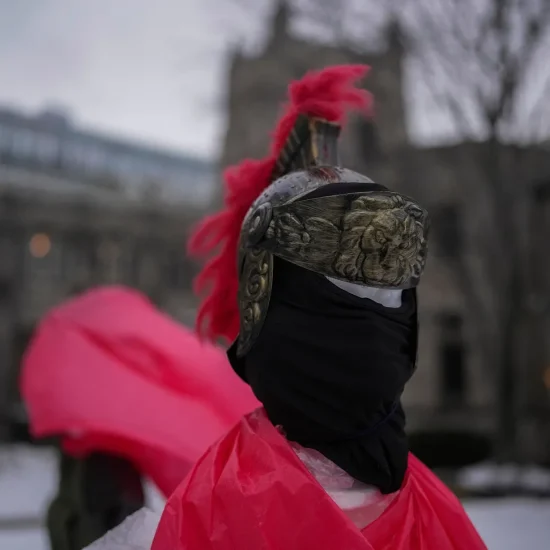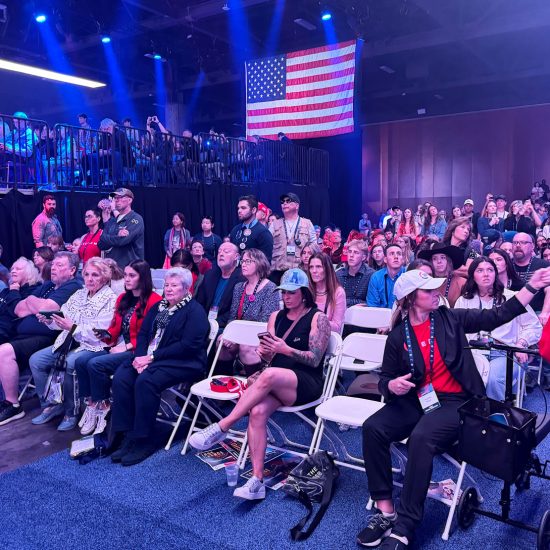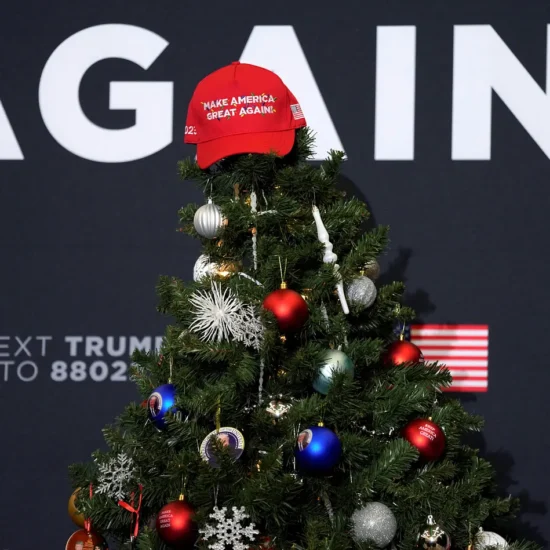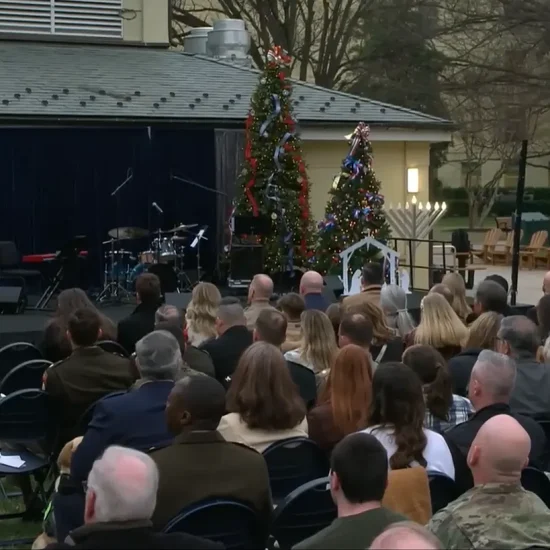
On Sunday (Sept. 29), former President Donald Trump interrupted his social media stream of attacks on Vice President Kamala Harris and immigrants to post a Catholic prayer. Along with a picture of Saint Michael the Archangel with a sword drawn while standing on Satan, Trump posted the “Prayer to Saint Michael the Archangel” that Pope Leo XIII added in 1886 to the prayers said after Mass.
“Saint Michael the Archangel, defend us in battle,” Trump wrote. “Be our defense against the wickedness and snares of the Devil. May God rebuke him, we humbly pray, and do thou, O Prince of the heavenly hosts, by the power of God, cast into hell Satan, and all the evil spirits, who prowl about the world seeking the ruin of souls. Amen.”
Trump’s post wasn’t random. He made it on the Catholic feast day of Saint Michael the Archangel. Additionally, it actually marked the second time in September that Trump made a social media appeal to Catholics. Three weeks earlier, he had posted an image of Jesus’s mother Mary with the caption, “Happy Birthday Mary!” In the Catholic Church (and some other traditions like the Anglican Communion), September 8 is celebrated as Mary’s birthday. Ironically, the Mexico-bashing politician posted a Mexican image of Mary.

Trump’s appeals to Catholic voters make sense electorally. Despite the media over-attention to White evangelicals, Catholics along with mainline Protestants and the religiously unaffiliated are the voters who will actually decide the election. But the Michael post connected more powerfully than his Mary post with a fringe part of the Catholic world because of their veneration of Michael. Long considered the patron saint of police, Michael the Archangel is also a favorite among far-right Catholics who defend the violence of the Jan. 6 insurrection, push COVID-19 conspiracies, talk about spiritual warfare, and lift up Trump as God’s ordained candidate.
While a few reporters noted Trump’s Michael post as a generic appeal to Catholic voters, there’s something deeper going on. It highlights his links to an extreme, anti-democratic subset of American Catholicism. So this issue of A Public Witness unpacks the devotion to Saint Michael the Archangel and what it means for our politics today.
Prayer for Spiritual Battle
The Prayer to Saint Michael the Archangel entered Catholic worship at a time when the popes considered themselves prisoners inside the Vatican. The Papal States, territories under the rule of popes since the eighth century, had fallen in 1870 as the Kingdom of Italy took control of Rome. But as Italy unified as a nation and confiscated some papal properties, Italian forces didn’t enter the Vatican compound. This “prisoner” status for popes ended in 1929 with the creation of Vatican City, thus returning a bit of secular power to the papacy.
Leo XIII served as pope from 1878-1903, thus a main figure in that in-between time as the Vatican found itself suddenly with no geopolitical power. So in 1884, he created the Leonine Prayers, named for the wall enclosing Rome that Pope Leo IV had built in the ninth century. Two years later, Leo XIII added the Michael prayer to the Leonine Prayers that were to be offered in defense of the beleaguered Holy See.
The reforms of Vatican II in 1964 brought an end to the requirement of reciting the Leonine Prayers following Mass. However, they still sometimes popped up. Pope Paul John II recommended Catholics say the Prayer to Saint Michael the Archangel, connecting it to Paul’s teaching in Ephesians 6 about the “armor of God” in addition to the passage in Revelation 12 about Michael defeating the dragon.
“May prayer strengthen us for the spiritual battle,” John Paul II said in 1994. “Although this prayer is no longer recited at the end of Mass, I ask everyone not to forget it and to recite it to obtain help in the battle against the forces of darkness and against the spirit of this world.”
Similarly, Pope Francis used his remarks on the feast day of Michael in 2018 to urge Catholics to pray the Rosary every day in October and say the Prayer to Saint Michael the Archangel. He made this request shortly after retired Archbishop Carlo Viganò publicly accused Francis of covering up allegations of sexual misconduct, though investigations cast doubts on some of Viganò’s claims. So in that context, Francis asked for people to say the Michael prayer “to protect the Church from the devil.” Other Catholic leaders echoed Francis’s call to recite the prayer more, highlighting the prayer’s emphasis on “spiritual battle.”
That wasn’t the last time Viganò and Francis sparred. Viganò later embraced COVID-19 conspiracy theories, spoke at a pro-Trump event trying to overturn the 2020 presidential election, urged fasting to support those arrested for participating in the Jan. 6 insurrection, and supported Russia’s invasion of Ukraine. After working last year to create an association and a seminary opposed to the reforms of Vatican II, Viganò this year announced he didn’t recognize Francis’s authority and accused the pope of heresy. That led to Viganò’s excommunication.
While Catholic leaders like Pope Francis have invoked Michael and Pope Leo XIII’s prayer to Michael, the veneration of the fighting angel has been particularly strong among Trumpian Catholics aligned with Viganò. Some of them are in Trump’s orbit and quickly lifted up his social media post as a sign of the former president’s holiness.
Help sustain the journalism ministry of Word&Way by subscribing to A Public Witness!
In early August, a group calling itself Catholics for Catholics launched a campaign to put a religious-themed billboard in swing states to glorify Trump for surviving an assassination attempt in Butler, Pennsylvania. The billboard features Trump raising his fist while shouting “fight” in front of an American flag next to Michael holding a sword. In addition to “Catholics for Catholics,” the billboard declares in big letters, “St. Michael the Archangel, Defend us in Battle!”
“It’s not just about physical safety; this is a spiritual battle,” the group said as they raised funds for the billboards. “Interested in joining us? Start by faithfully reciting the Saint Michael Prayer daily.”
The group has a couple dozen billboards up in five states — including one near the site of the July rally where Trump was shot and two others in Butler. Trump will return to that site in Butler for a rally on Saturday. And the group is selling T-shirt versions of the Trump-Michael image.
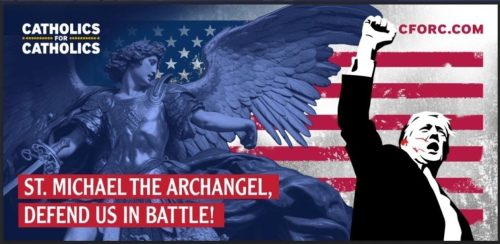
Catholics for Catholics image for their billboard in swing states.
The choice of sword-wielding angel as the billboard saint is no accident. The group launched in 2022 on the feast day of Saint Michael the Archangel. On their one-year anniversary last year, the group held a “Consecration to St. Michael the Archangel” event with disgraced former Lt. Gen. Michael Flynn and Bishop Joseph Strickland (who was removed from his position shortly thereafter by Pope Francis after a monthslong investigation into his social media behavior and governance issues). Both Flynn and Strickland have pushed COVID-19 conspiracies and spoke at events after the 2020 election as they tried to overturn the results, and Strickland supported Viganò in his allegations against Francis.
“We want to be warriors like him [Michael],” declared the group’s leader, John Yep, during the consecration event. “As so many people have said, we are in a civil war, a spiritual civil war for the life of this nation. And the world depends on what happens in the United States of America.”
Flynn, who serves as a senior advisor of Catholics for Catholics, also spoke about being inspired by Michael the Archangel, saying his parents named him after that saint. Flynn often invokes his Catholic faith at events like the ReAwaken America Tour as pushes his vision of spiritual warfare and Christian Nationalism.
“This is synonymous to what it is that we’re dealing with today in our own country and our own lives: Saint Michael the Archangel was engaged in a cosmic battle against Satan. And we live in a time of really spiritual warfare,” Flynn said during the consecration event. “This is a good-versus-evil spiritual form of warfare.”
Strickland led the event in saying the Prayer to Saint Michael the Archangel, and he encouraged people to take up the practice of saying it at least daily.
In March, Catholics for Catholics hosted a “Catholic Prayer for Trump” event at Trump’s Mar-a-Lago. The $1,000-a-ticket dinner featured remarks by Flynn, political trickster Roger Stone, actor Jim Caviezel, conspiracy theorist Jack Posobiec, defrocked former priest Frank Pavone, and Tim Ballard (an anti-trafficking activist accused of multiple sexual assaults). The speakers defended people arrested for their behavior during the Jan. 6 insurrection and blasted the House Select Committee that investigated the attack as doing Satan’s work. During the event, Caviezel compared Trump to Moses, called Trump “a prophet and a liberator in his own right,” claimed the presidency was stolen from Trump, and invoked Saint Michael the Archangel in the battle against “evil.” Caviezel also teaches the Chaplet of Saint Michael the Archangel (a longer and older prayer than the more popular Michael prayer) on the Catholic prayer app Hallow. The Mar-a-Lago event ended with the recitation of several prayers, including the Prayer to Saint Michael the Archangel.
Catholics for Catholics insists Trump won in 2020 and should be considered “the only Catholic option for 2024.” In June, the group launched a campaign to have 2,024 “Masses for Trump” held before the election. They later suggested their effort had helped protect Trump’s life in Butler. And their event this year for the feast day of Michael featured a conversation with a former FBI analyst who has pushed rightwing narratives about the Jan. 6 insurrection.
Beyond the organization behind the pro-Trump billboards, Saint Michael the Archangel also pops up in numerous other far-right spaces.
At the influential Conservative Political Action Conference in 2022, a man in an orange outfit and a red MAGA hat sat barefoot inside a mock prison cell. Attendees were invited to consider the plight of people imprisoned because of their activities during the Jan. 6 insurrection the year before. Rep. Marjorie Taylor Greene of Georgia got down on her knees in prayer inside the cell with the actor. The crowd recited the Lord’s Prayer, and then a man in the front loudly offered the Prayer to Saint Michael the Archangel. However, he edited the ending. Instead of “who prowl about the world seeking the ruin of souls,” he asked Michael to cast into hell Satan and the evil spirits responsible for “this bondage that’s going on in our country.” After ending his prayer “in Jesus’s name,” the crowd erupted with shouts of “amen!”
On July 1, former Trump strategist Steve Bannon surrendered to serve four months in prison for contempt of Congress after refusing to cooperate with the House Select Committee that investigated the Jan. 6 insurrection. Striking a defiant tone in a press conference that day, Bannon was joined by a priest. After Bannon attacked his political enemies, the priest pledged to help Bannon and said the Prayer to Saint Michael the Archangel. Bannon, who has called himself a “proud Christian Nationalist,” is a Catholic who has worked to push the Church in a more conservative direction.
On Sunday as Trump posted about Michael, a pro-Trump gathering on the National Mall also included multiple references to Michael since it was his feast day. The “Rescue the Republic” rally was organized by anti-vax activists who built followers with COVID-19 conspiracies and fights against mask mandates. After opening music by the Christian rock band Skillet, whose lead singer is outspoken about his anti-“woke” conservative politics, key speakers at the rally including Trump-backing conspiracy theorists like Robert Kennedy Jr. (a Catholic who was carrying a Michael medallion), Lara Logan, and Jordan Peterson. Emcee Rob Schneider, who’s been an anti-vax activist for years, invoked Michael in between making jokes that made his movies actually seem funny.
“Thank you, Jesus, for bringing all these brothers and sisters together in one place safely,” declared Schneider, who converted to Catholicism last year. “Today is the day [of] Saint Michael the Archangel to defend. He’s in battle and is here to protect us against wickedness. That is today. That’s no accident. We’re grateful to be here.”
Later during the event, British actor Russell Brand spoke and voiced a prayer, offering his plea that America would be “one nation under God,” giving his defense of people who stormed the Capitol during the Jan. 6 insurrection, and making his request that the nation would be saved from totalitarian bureaucracy. Before leading the crowd in saying the Lord’s Prayer, he added his hope that “we may all serve in your name on the day of the feast of Saint Michael.” Amid allegations he committed multiple sexual assaults, Brand announced earlier this year he had become a Christian — albeit with some vagueness, but he’s also talked about praying the Rosary and is promoting the Catholic prayer app Hallow. More recently, he sparked controversy as he baptized people in a river while just in his underwear — which is less Catholic than evangelical Tarzan.
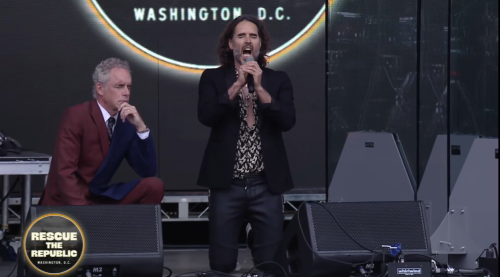
Screengrab as Russell Brand (right) prays as Jordan Peterson listens during the “Rescue the Republic” rally in Washington, D.C., on Sept. 29, 2024.
The Prayer to Saint Michael was also offered as the opening prayer during the Republican National Convention this year on the night Trump gave his acceptance address.
Although Pope Leo XIII wrote his Prayer to Saint Michael the Archangel to promote the political power of the Vatican, the sword-wielding figure now often shows up at political rallies mixed with conspiracies about COVID-19, the 2020 election, and the Jan. 6 insurrection. This is the potent symbol Trump tapped into with his post on Sunday.
Get cutting-edge analysis and commentary like this in your inbox every week by subscribing today!
Call to Battle
Obviously, not everyone who prays the Prayer to Saint Michael the Archangel is a Trumpian conspiracy theorist. The prayer existed for more than a century before Trump’s political rise. But the enthusiastic embrace of the prayer and the saint by those on the far-right shows the danger of the co-option of sacred symbols and language. Much like White supremacists have reappropriated the Christian flag and the slogan “Christ is King,” the same seems to be occurring with Michael and Pope Leo XIII’s prayer.
Michael, the patron saint of police officers, has also long been popular among military members — in the U.S. and other nations. This makes sense given the fighting imagery of him defeating Satan and the prayer requesting he “defend us in battle.” Many soldiers sport medallions or tattoos of the “killer angel.” But this embrace has also been by fascist military leaders, like Corneliu Codreanu in Romania. In 1927, the Orthodox politician created the Legion of the Archangel Michael, a fascist political party characterized by its anti-democratic and antisemitic agenda. He also later established the Iron Guard as a paramilitary wing of the Legion, and its symbol known as “St. Michael’s Cross” is used today by White supremacists.
Others have warned of the embrace of Michael by White supremacists in the United States. The founder of Black Rifle Coffee, which brands itself as a conservative company, told the New York Times he had considered using an image of Michael shooting a rifle as a design for a coffee bag. However, the former Green Beret who had worn a Michael pendant in combat added that they scrapped the plan after he heard from a friend in the Pentagon that White supremacists were embracing Michael because they thought the classic image of the archangel standing on Satan looked like the Minnesota police officer killing George Floyd (especially since a lot of art depicts Satan as much darker than Michael).
The same uneasiness should exist as Trumpian figures embrace Michael and invoke him in their political fights. The spiritual warfare language associated with Michael and the prayer to him is more commonly heard in politics from charismatic figures like those in the New Apostolic Reformation than from Catholics. But Michael Flynn demonstrates the overlapping political and spiritual unions. Key figures speaking at his ReAwaken America Tour events include NAR “prophets” like Lance Wallanu and Julie Green who frequently frame U.S. politics as spiritual warfare as they claim God has ordained Trump to win and lead as a righteous ruler. The imagery of Michael and the prayer to him provides a familiar Catholic lens for embracing such theology. And it harkens back to pre-Vatican II days that the conspiracy theorist and schematic bishops and priests desire to make great again.
With far-right Catholics in Trump’s orbit glorifying the battling angel and framing their political opponents as satanic, Trump posting the Prayer to Saint Michael must not be misread as generic Catholic outreach. Just like he signaled the Proud Boys militia to “stand back and stand by,” he’s doing the same now to his more extreme Catholic supporters. He’s not trying to win votes; he’s making a call to battle.
As a public witness,
Brian Kaylor
A Public Witness is a reader-supported publication of Word&Way.
To receive new posts and support our journalism ministry, subscribe today.


